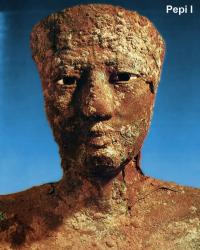Pepi II: Ninety-four years of reign
Pepi II, Pharaoh of the 6th Dynasty (2246-2152 BCE) is credited with the longest reign in Egyptian History: a full ninety-four years. The son of Pepi I and Ankhnesmeryre, who came from Abydos, he succeeded his half-brother Merenra at the age of only seven. Therefore, he was appointed regent by his mother along with one of his brothers, Djau, who had already served as grand vizier with Pepi I and was also from Abydos. The capital of the kingdom was in Memphis, however, given the various Nomarchs' growing desire for independence, it was politically important to strengthen ties with the southernmost parts of the country. So much so that Pepi I seems to have taken care to marry, in addition to Ankhnesmeryre, two other sisters, also from Abydos, daughters of a particularly influential local notable: a certain Khui.
Pepi II's very long reign did not record any special events and was a natural continuation of the policy followed until then. Some military campaigns in Nubia, which took the Egyptians as far as the area between the second and third cataracts, were victoriously carried out at the beginning of his effective rule. This enabled Egypt to secure the import of products and precious metals through the caravan routes from the Punt, which, in addition to the Sinai mines, made the country rich and prosperous. But as the years progressed, despite his excellent physical health, Pharaoh's will and mental clarity followed a steady decline. This fostered the ever-increasing claims of the Nomarchs who demanded autonomy, the Clergy who demanded exemptions and privileges, the rise of discontents and attempts at rebellion among the tax-overburdened lower classes, patronage and increasingly insecure borders.
The disintegration of the Old Kingdom was upon us. When Pepi II died, succession was not easy. A son Pepi II had had by his half-sister Neit was finally elected: Merenra II, who, however, reigned only a short time and was succeeded as the last Pharaoh of the 6th Dynasty by his blond wife Nitocri, who apparently died by suicide shortly thereafter.
Thus began the First Intermediate Period, which saw Egypt divided into various potentates and lasted until the 11th Dynasty of Thebes, ca. in 2130 B.C., to which the beginning of the Middle Kingdom is traced. Of the four Dynasties of this middle period attested by Manetho, we find some names of Pharaohs in the Abydos lists and the last two are called Heracleopolis.
Pepi II also had a pyramid built in the southern part of Saqqara. Only 50 meters high, it is little compared to those of his predecessors. Few objects remain from the period of his reign. One is an alabaster headrest that bears his cartouche and is currently on display in the Louvre museum.






























